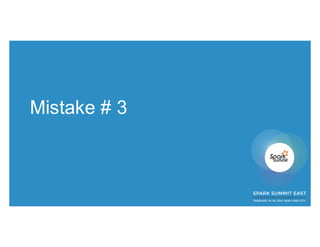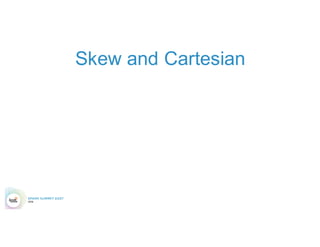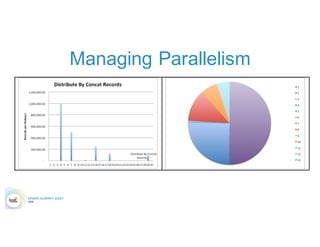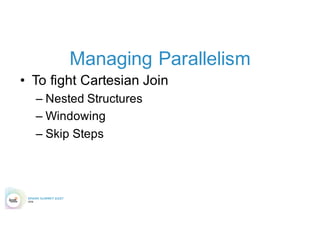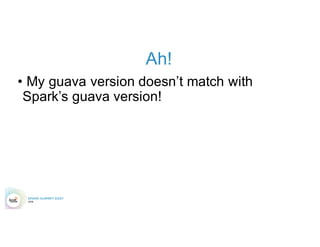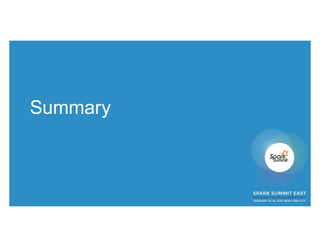Top 5 Mistakes to Avoid When Writing Apache Spark Applications
- 1. Top 5 Mistakes when writing Spark applications Mark Grover | @mark_grover | Software Engineer Ted Malaska | @TedMalaska | Principal Solutions Architect tiny.cloudera.com/spark-mistakes
- 2. About the book • @hadooparchbook • hadooparchitecturebook.com • github.com/hadooparchitecturebook • slideshare.com/hadooparchbook
- 3. Mistakes people make when using Spark
- 4. Mistakes people we made when using Spark
- 5. Mistake # 1
- 6. # Executors, cores, memory !?! • 6 Nodes • 16 cores each • 64 GB of RAM each
- 7. Decisions, decisions, decisions • Number of executors (--num-executors) • Cores for each executor (--executor-cores) • Memory for each executor (--executor- memory) • 6 nodes • 16 cores each • 64 GB of RAM
- 9. Answer #1 – Most granular • Have smallest sized executors as possible • 1 core each • Total of 16 x 6 = 96 cores • 96 executors • 64/16 = 4 GB per executor (per node)
- 10. Answer #1 – Most granular • Have smallest sized executors as possible • 1 core each • Total of 16 x 6 = 96 cores • 96 executors • 64/16 = 4 GB per executor (per node)
- 11. Why? • Not using benefits of running multiple tasks in same JVM
- 12. Answer #2 – Least granular • 6 executors • 64 GB memory each • 16 cores each
- 13. Answer #2 – Least granular • 6 executors • 64 GB memory each • 16 cores each
- 14. Why? • Need to leave some memory overhead for OS/Hadoop daemons
- 15. Answer #3 – with overhead • 6 executors • 63 GB memory each • 15 cores each
- 16. Answer #3 – with overhead • 6 executors • 63 GB memory each • 15 cores each
- 17. Spark on YARN – Memory usage • --executor-memory controls the heap size • Need some overhead (controlled by spark.yarn.executor.memory.overhead)for off heap memory • Default is max(384MB, .07 * spark.executor.memory)
- 18. YARN AM needs a core: Client mode
- 19. YARN AM needs a core: Cluster mode
- 20. HDFS Throughput • 15 cores per executor can lead to bad HDFS I/O throughput. • Best is to keep under 5 cores per executor
- 21. Calculations • 5 cores per executor – For max HDFS throughput • Cluster has 6 * 15 = 90 cores in total (after taking out Hadoop/Yarn daemon cores) • 90 cores / 5 cores/executor = 18 executors • 1 executor for AM => 17 executors • Each node has 3 executors • 63 GB/3 = 21 GB, 21 x (1-0.07) ~ 19 GB (counting off heap overhead)
- 22. Correct answer • 17 executors • 19 GB memory each • 5 cores each * Not etched in stone
- 23. Read more • From a great blog post on this topic by Sandy Ryza: http://blog.cloudera.com/blog/2015/03/how- to-tune-your-apache-spark-jobs-part-2/
- 24. Mistake # 2
- 25. Application failure 15/04/16 14:13:03 WARN scheduler.TaskSetManager: Lost task 19.0 in stage 6.0 (TID 120, 10.215.149.47): java.lang.IllegalArgumentException: Size exceeds Integer.MAX_VALUE at sun.nio.ch.FileChannelImpl.map(FileChannelImpl.java:828) at org.apache.spark.storage.DiskStore.getBytes(DiskStore.scala:123) at org.apache.spark.storage.DiskStore.getBytes(DiskStore.scala:132) at org.apache.spark.storage.BlockManager.doGetLocal(BlockManager.scala:51 7) at org.apache.spark.storage.BlockManager.getLocal(BlockManager.scala:432) at org.apache.spark.storage.BlockManager.get(BlockManager.scala:618) at org.apache.spark.CacheManager.putInBlockManager(CacheManager.scala:146 ) at org.apache.spark.CacheManager.getOrCompute(CacheManager.scala:70)
- 26. Why? • No Spark shuffle block can be greater than 2 GB
- 27. Ok, what’s a shuffle block again? • In MapReduce terminology, a Mapper- Reducer pair – the file from local disk that the reducers read from local disk in MapReduce.
- 28. In other words Each yellow arrow in this diagram represents a shuffle block.
- 29. Wait! What!?! This is Big Data stuff, no? • Yeah! Nope! • Spark uses ByteBuffer as abstraction for storing blocks val buf = ByteBuffer.allocate(length.toInt) • ByteBuffer is limited by Integer.MAX_SIZE(2 GB)!
- 30. Once again • No Spark shuffle block can be greater than 2 GB
- 31. Spark SQL • Especially problematic for Spark SQL • Default number of partitions to use when doing shuffles is 200 – This low number of partitions leads to high shuffle block size
- 32. Umm, ok, so what can I do? 1. Increase the number of partitions – Thereby, reducing the average partition size 2. Get rid of skew in your data – More on that later
- 33. Umm, how exactly? • In Spark SQL, increase the value of spark.sql.shuffle.partitions • In regular Spark applications, use rdd.repartition() or rdd.coalesce()
- 34. But, how many partitions should I have? • Rule of thumb is around 128 MB per partition
- 35. But! • Spark uses a different data structure for bookkeeping during shuffles, when the number of partitions is less than 2000, vs. more than 2000.
- 36. Don’t believe me? • In MapStatus.scala def apply(loc: BlockManagerId, uncompressedSizes: Array[Long]): MapStatus = { if (uncompressedSizes.length > 2000) { HighlyCompressedMapStatus(loc, uncompressedSizes) } else { new CompressedMapStatus(loc, uncompressedSizes) } }
- 37. Ok, so what are you saying? • If your number of partitions is less than 2000, but close enough to it, bump that number up to be slightly higher than 2000.
- 38. Can you summarize, please? • Don’t have too big partitions – Your job will fail due to 2 GB limit • Don’t have too few partitions – Your job will be slow, not making using of parallelism • Rule of thumb: ~128 MB per partition • If #partitions < 2000, but close, bump to just > 2000
- 39. Mistake # 3
- 40. Slow jobs on Join/Shuffle • Your dataset takes 20 seconds to run over with a map job, but take 4 hours when joined or shuffled. What wrong?
- 42. Mistake - Skew Single Thread Single Thread Single Thread Single Thread Single Thread Single Thread Single Thread Normal Distributed The Holy Grail of Distributed Systems
- 43. Mistake - Skew Single Thread Normal Distributed What about Skew, because that is a thing
- 44. Mistake – Skew : Answers • Salting • Isolation Salting • Isolation Map Joins
- 45. Mistake – Skew : Salting • Normal Key: “Foo” • Salted Key: “Foo” + random.nextInt(saltFactor)
- 47. Mistake – Skew: Salting
- 49. Mistake – Skew : Salting • Two Stage Aggregation – Stage one to do operations on the salted keys – Stage two to do operation access unsalted key results Data Source Map Convert to Salted Key & Value Tuple Reduce By Salted Key Map Convert results to Key & Value Tuple Reduce By Key Results
- 50. Mistake – Skew : Isolated Salting • Second Stage only required for Isolated Keys Data Source Map Convert to Key & Value Isolate Key and convert to Salted Key & Value Tuple Reduce By Key & Salted Key Filter Isolated Keys From Salted Keys Map Convert results to Key & Value Tuple Reduce By Key Union to Results
- 51. Mistake – Skew : Isolated Map Join • Filter Out Isolated Keys and use Map Join/Aggregate on those • And normal reduce on the rest of the data • This can remove a large amount of data being shuffled Data Source Filter Normal Keys From Isolated Keys Reduce By Normal Key Union to Results Map Join For Isolated Keys
- 52. Managing Parallelism Cartesian Join Map Task Shuffle Tmp 1 Shuffle Tmp 2 Shuffle Tmp 3 Shuffle Tmp 4 Map Task Shuffle Tmp 1 Shuffle Tmp 2 Shuffle Tmp 3 Shuffle Tmp 4 Map Task Shuffle Tmp 1 Shuffle Tmp 2 Shuffle Tmp 3 Shuffle Tmp 4 ReduceTask ReduceTask ReduceTask ReduceTask Amount of Data Amount of Data 10x 100x 1000x 10000x 100000x 1000000x Or more
- 53. Managing Parallelism • To fight Cartesian Join – Nested Structures – Windowing – Skip Steps
- 54. Mistake # 4
- 55. Out of luck? • Do you every run out of memory? • Do you every have more then 20 stages? • Is your driver doing a lot of work?
- 56. Mistake – DAG Management • Shuffles are to be avoided • ReduceByKey over GroupByKey • TreeReduce over Reduce • Use Complex Types
- 57. Mistake – DAG Management: Shuffles • Map Side Reducing if possible • Think about partitioning/bucketing ahead of time • Do as much as possible with a single Shuffle • Only send what you have to send • Avoid Skew and Cartesians
- 58. ReduceByKey over GroupByKey • ReduceByKey can do almost anything that GroupByKey can do • Aggregations • Windowing • Use memory • But you have more control • ReduceByKey has a fixed limit of Memory requirements • GroupByKey is unbound and dependent of the data
- 59. TreeReduce over Reduce • TreeReduce & Reduce returns a result to the driver • TreeReduce does more work on the executors • Where Reduce bring everything back to the driver Partition Partition Partition Partition Driver 100% Partition Partition Partition Partition Driver 4 25% 25% 25% 25%
- 60. Complex Types • Top N List • Multiple types of Aggregations • Windowing operations • All in one pass
- 61. Complex Types • Think outside of the box use objects to reduce by • (Make something simple)
- 62. Mistake # 5
- 63. Ever seen this? Exception in thread "main" java.lang.NoSuchMethodError: com.google.common.hash.HashFunction.hashInt(I)Lcom/google/common/hash/HashCode; at org.apache.spark.util.collection.OpenHashSet.org $apache$spark$util$collection$OpenHashSet$$hashcode(OpenHashSet.scala:261) at org.apache.spark.util.collection.OpenHashSet$mcI$sp.getPos$mcI$sp(OpenHashSet.scala:165) at org.apache.spark.util.collection.OpenHashSet$mcI$sp.contains$mcI$sp(OpenHashSet.scala:102) at org.apache.spark.util.SizeEstimator$$anonfun$visitArray$2.apply$mcVI$sp(SizeEstimator.scala:214) at scala.collection.immutable.Range.foreach$mVc$sp(Range.scala:141) at org.apache.spark.util.SizeEstimator$.visitArray(SizeEstimator.scala:210) at…....
- 64. But! • I already included guava in my app’s maven dependencies?
- 65. Ah! • My guava version doesn’t match with Spark’s guava version!
- 67. Summary
- 68. 5 Mistakes • Size up your executors right • 2 GB limit on Spark shuffle blocks • Evil thing about skew and cartesians • Learn to manage your DAG, yo! • Do shady stuff, don’t let classpath leaks mess you up
- 69. THANK YOU. tiny.cloudera.com/spark-mistakes Mark Grover | @mark_grover Ted Malaska | @TedMalaska













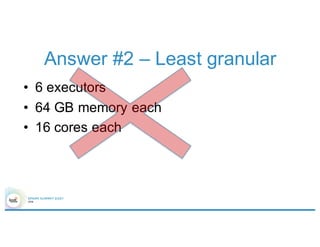






















![Don’t believe me?
• In MapStatus.scala
def apply(loc: BlockManagerId, uncompressedSizes:
Array[Long]): MapStatus = {
if (uncompressedSizes.length > 2000) {
HighlyCompressedMapStatus(loc,
uncompressedSizes)
} else {
new CompressedMapStatus(loc, uncompressedSizes)
}
}](https://image.slidesharecdn.com/top5mistakesv4160218171402-160218190042/85/Top-5-Mistakes-to-Avoid-When-Writing-Apache-Spark-Applications-36-320.jpg)


